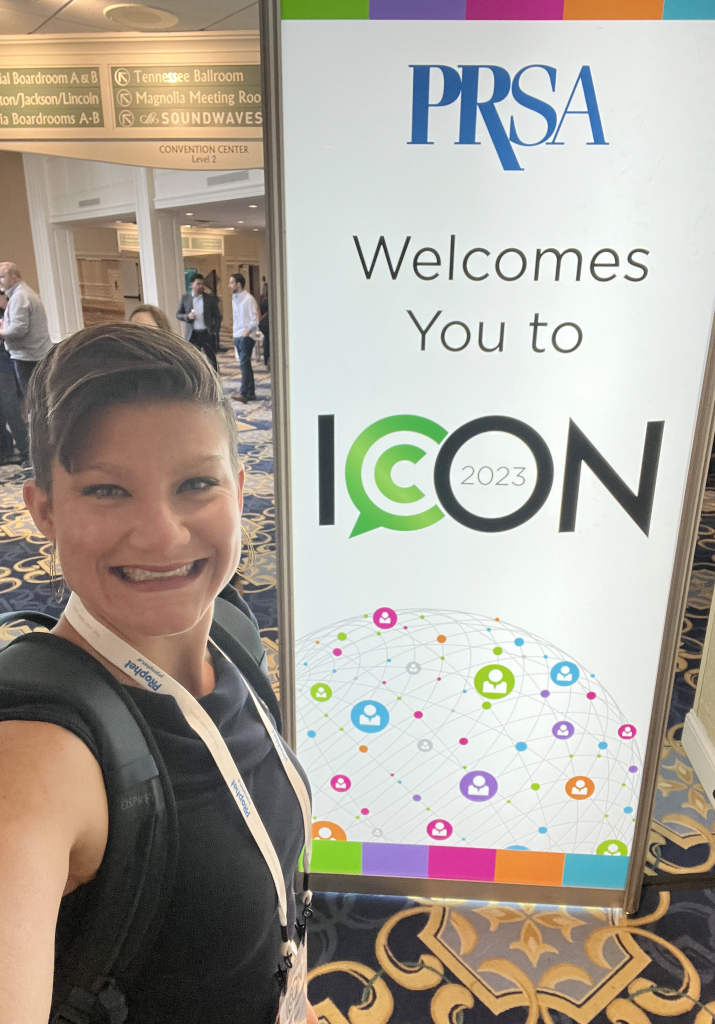With the rapid changes and uncertainty brought on by the novel COVID-19 pandemic, it hasn’t been easy for our education partners. We had a chance to connect with Molly McGowan Gorsuch, the public information officer for Henderson County Public Schools, a 23-school district in Western North Carolina, and get her perspective on how her district has been impacted by the coronavirus. She is a proud board member of the North Carolina School Public Relations Association and an active member of NSPRA, is a charter member of the Public Relations Society of America’s WNC Chapter, and serves on the Henderson County Education Foundation board.
RB: How would you describe your professional climate right now?
MMG: It’s been tense and frazzled, but also incredibly collaborative. We’ve been trading graphics, messaging templates, and best practices like Halloween candy. From Day 1, public relations professionals in K-12, healthcare, and private agencies have put out offers to shoulder the burden together. A #SchoolPRpro needs only to throw out a bat signal on Twitter, email, or professional association discussion page, and a Google Drive link of shared resources is being dropped into their inbox, along with an encouraging word. I’ve always appreciated my National School Public Relations Association and NCSPRA networks, but I’ve never valued their hivemind expertise more than I do now.
RB: Are you working remotely?
MMG: I was maintaining regular office hours (which – let’s be honest – are anything but regular for PR folks even under normal circumstances) through March 18. I began working from home on March 19, when I learned that I had been in contact with someone who was being tested for COVID-19. Out of an abundance of caution, I self-isolated and began working from home to wait out the results of my contact’s test. It turned out negative, but by the time I had the results, our district was encouraging staff who could work from home to make the transition – so I’ve set up camp at my dining room table with my husband, who’s also working from home.
RB: Are you and your team utilizing any Zoom, Google Hangouts or Skype virtual meetings?
MMG: I feel like I’ve downloaded the entire cache of virtual meeting apps in the past month! Our district’s directors and principals use GoToMeeting daily for a morning briefing on state and local educational decisions and public health updates. In our schools’ brand new remote learning model, teachers are using Google Chat and Meet daily to connect with their students and host “office hours,” and I’ve used it to lead a virtual training session. My standing Friday meeting with regional public health communicators is hosted on Adobe Connect, and I’ve used Zoom to trade best practices and battle stories with my Western North Carolina #SchoolPR peers. I also used Skype to call in for a radio interview, since the local station is operating remotely to practice social distancing.
RB: How are you and your district leaders getting their COVID-19 updates?
MMG: Of course, the Centers for Disease Control and Prevention, N.C. Department of Health & Human Services, and our local Henderson County Department of Public Health (HCDPH) provide us with specific public health directives; the N.C. Department of Public Instruction and Gov. Roy Cooper press conferences are where we look for guidance on K-12 operations during the school closure.
In the spirit of collaboration I mentioned earlier, everyone is on a myriad of teams, committees, and subcommittees where information and best practices are shared. I’m in my 5th year serving on the county’s Local Health Information Team, composed of health practitioners and communicators from the HCDPH, emergency management, area hospitals and clinics, and other health and human services organizations. In addition to our now-weekly meetings, I also participate in a Friday round-robin of “what’s working, what resources can we share” virtual meeting with health department communicators in the greater Western North Carolina region.
I can’t speak for every single workgroup the members of our Leadership Team are on, but I know that our superintendent is part of the NCDPI’s weekly superintendent check-in, and serves on state subcommittees. As of April 3, I’m also attending a weekly PIO/Communications Leaders Check-In hosted by NCDPI’s recently formed COVID-19 Communications Work Team.
Invaluable #SchoolPR resources have included the NSPRA Connect discussion boards, a private “school communications pros discussion page” Facebook group, and the less formal (but equally helpful) group chats with fellow North Carolina School Public Relations Association board members and my #WNCschoolPRpros in Asheville City Schools, Buncombe County Schools, and Transylvania County Schools.
RB: What channels are you utilizing most to share updates and communicate with your community?
MMG: During this time of uncertainty, I’ve made a conscious effort to provide consistency to our HCPS Family in our messaging – both internally and externally. Following HCPS’ initial response to COVID-19 in early March, HCPS set the expectation that the district will share a Community Health Advisory Update each Friday – in addition to any emergent communications during the week. All Community Health Advisory Updates are:
- Externally sent to parents through Peachjar
- Posted as an article online
- Linked to our district’s dedicated COVID-19 information page
- Shared on our social media
When the updates contain relevant external messaging applicable to the community beyond our schools, they’re also sent to traditional media. Especially urgent or time-sensitive messages are also recorded as SchoolMessenger calls to families in English and Spanish.
RB: What are the most common questions you’ve received from your community members so far?
MMG: Honestly, the questions change daily – sometimes hourly – in response to whatever new information we’re able to present. First the main question was, “Are schools going to close?” That decision was made for us when Gov. Roy Cooper issued the executive order on March 14 closing all K-12 schools in North Carolina. Immediately, the questions became, “Will the schools be implementing remote learning?” and “Will the school system be feeding children?” It was interesting to see that, not just in our region but across the nation, the public’s main concerns and offers of support centered around providing meals to children over the shutdown. I think this response – and K-12 districts’ adaptability in meeting this overwhelming need – is indicative of the extent and quality of services public education provides in our country.
Once meals were addressed and our new Learn from Home model was launched, questions turned to grading: “How will remote learning lessons be graded?” “What about senior graduation requirements?” Again, answers we couldn’t give until we had guidance from the state.
When we had our first employee test positive for COVID-19 last week, our families wanted to know at which school the employee works. Though not included in our initial statement, we shared this detail the following day accompanied with relevant information from the health department (more on that later).
RB: What advice is your district giving?
MMG: First and foremost, we’re echoing every bit of public health advice local and state health officials are providing. Initially, that focused on handwashing, but now it’s moved to social distancing and reminding families of the county and state “stay at home” orders. We also remind concerned individuals that the health department runs point on investigating “close contacts” of all positive cases in the community – school-related or otherwise – so they would be notified by HCDPH if health officials believed there was a possibility they’d had contact with COVID-19. We advise families to reach out to us if their children need school meals but lack transportation to our pick-up or delivery sites, so schools can deliver meals directly to them. And we remind families of available community resources for food, utilities, and other essentials.
RB: What challenges have you faced during this novel pandemic?
MMG: The logistics of establishing new COVID-19 internal protocols, mapping and mobilizing new bus routes to deliver meals, developing brand new virtual learning, organizing staff into new “duties as assigned” on the fly, preparing thousands of Chromebooks for student rental, etc. means that even a district’s most efficient turnaround times in addressing each new shutdown surprise feels delayed to the public. So families are having to do a lot of “hurry up and wait” for answers.
I think what’s been frustrating for communicators in all fields during this pandemic is the fact that no matter how proactively we work to communicate what we know when we know it, it’s never enough and it’s bound to change immediately. New information breeds new questions, which can’t always be answered as quickly as the public demands in this atmosphere. And this demand is only heightened by the immediacy of social media. Though I’ve worked diligently over the past six years to create a culture of two-way communication on the district’s social platforms, each question on Facebook or comment on Twitter or Instagram triggers a jarring startle response in me. To be fair, that response is part of what makes School PR pros reliable, quick communicators; but in crisis communications this invisible tether to our phones quickly becomes time consuming as well as mentally and emotionally draining.
RB: What PR best practices have helped you navigate how to communicate to students, parents, fellow staff and the community?
MMG: Consistency: Immediately after making our first district statement, we established that HCPS would be sharing situational updates each Friday, and where families should look for accurate district updates: Peachjar emails, our website, HCPS socials, traditional media, and alert calls.
Two-way Communication: Whether it’s me responding to Facebook comments, our Technology Department manning a new Learn from Home helpline, or each principal answering phone calls from their schools’ parents, our efforts to deliver timely responses seem to have built trust among our district’s stakeholders.
Regarding social media, I’m navigating how to balance this heightened workplace demand with my own wellness, but I know that since we’ve set the precedent that families can come to us with questions during this closure period, I need to be diligent in finding answers for them as they come.
Transparency: When we had our first employee test positive for COVID-19 last week, we communicated the positive case with our HCPS Family to be transparent even though school isn’t in session. Despite reminding families that local public health officials are the authority in identifying positive cases and and would be following up with anyone in the community who could be considered “close contacts,” our social media blew up with parents wanting to know where the employee worked – in case they’d come in contact while picking up a Chromebook or meals. I shared this detail the following day – strategically accompanied with the confirmed info that 1) the employee had NOT been involved in distributing any meals or educational materials before becoming symptomatic, 2) as soon as the employee felt unwell, they’d followed public health recommendations to go home and self-isolate while awaiting test results, and 3) health officials had completed their contact tracing for those who would be considered “close contacts” – so anyone who should be concerned would have already been notified. Our families truly appreciated the transparency in naming the school and have been commenting messages of support, prayer, and healing for our employee.
Equity of Communication: We have a large population of families whose home language is Spanish, so I’ve worked extremely closely with our ESL Family Liaison (Evelyn) and ESL Instructional Facilitator (Omar) to translate every written, recorded, and social media COVID-19 update so it’s presented in English and Spanish simultaneously. While important district alerts in the past have gone out in Spanish, this is a truly coordinated effort that’s setting a precedent for HCPS crisis communications I’ve been working toward for a year. Though crisis communications wasn’t necessarily in their wheelhouse before the pandemic, Evelyn and Omar immediately understood the urgency of the translations I began throwing their way, and we’ve established an efficient workflow that will prove beneficial for future crisis communication needs.
Touchpoints: We’re making sure to give our families multiple methods of accessing official HCPS information so if they miss one touchpoint, they have other reliable locations to check. And we know not all of our families have access to the Internet so when it came to sharing important public health information, our health department and I collaborated on a guerilla marketing tactic. On their behalf, I designed a bilingual sticker with NCDHHS social distancing facts and local helplines, which our school nutrition department is sticking on the thousands of meals we’re distributing weekly.
RB: Are you facing any specific communication roadblocks?
MMG: One afternoon, I needed to record the day’s second crucial SchoolMessenger alert, using language we were posting online. From delivery complications of our first message, I’d learned I needed to include both my English version and Omar’s Spanish version in the same message (not recorded and sent separately) to guarantee delivery to all subscribed users. The message was long, and we either needed to cut content or talk fast. Administrators wanted all content included, so Omar and I did some fast-talking. We heard some feedback that we were hard to understand, and it was frustrating that our focus on equity of communication was literally lost in translation. Thankfully, having multiple messaging touchpoints proved valuable, so we could direct families to additional sources if they’d had a hard time understanding the call.
Also, as seems to be the case in many counties, our local health department doesn’t have department-specific social media accounts; public health messages share the stage with other departments’ topics on the official county government Facebook page (and the county has a Twitter profile, but it’s been inactive since June 2019). Although the county Facebook has made a concerted effort to focus its posts primarily on directives from its department of public health, it’s impossible for HCPS to directly share or retweet HCDPH-branded messages that can clearly be traced back to the health department.
RB: What tips would you give to other PR professionals that have helped you personally through this crisis?
MMG: Know and respect your bandwidth. Yes, this is a time of collaboration, and you’re likely being asked to weigh in on messaging, help with graphic design, or otherwise lend your skills to a partner organization. I support this wholeheartedly – it’s for the good of local and global public health, after all – and there’s no reason to reinvent the wheel when communicators can share their resources. But you also need to take care of yourself. When we stretch ourselves too thin, we become more susceptible to physical illness and emotional burnout – and our districts need us healthy now more than ever.
Allow yourself to feel the uncomfortable emotions. Early on in the pandemic, I found myself crying at work – I’m talking head-down-on-desk, suddenly totally drained, wracked with emotions I hadn’t realized I’d been holding onto until I stopped to breathe. It hit me that, in our roles as professional communicators for entire school districts, we so often don’t allow ourselves to pause for our own mental breaks. We should grant ourselves extra grace to feel – and respond to – our emotions even more intensely, and by accepting them we can move on.
Find yourself a hobby that doesn’t involve screen time. We’re glued to governor’s press conferences on television, social media on our phones, and web conferencing on our computers. In your off time, try to actively disconnect. This one’s hard for me, but luckily I have a helpful husband who will steal my phone when he can tell I need a break.
RB: On a personal level, what are you doing to maintain a positive outlook and be productive?
MMG: I’m trying to exercise 5-6 times a week, either participating in home workouts my CrossFit coach is programming for members, or running. While also a stress reliever, doing so logs points for my CrossFit HVL #QuaranTeam (a socially distant, friendly competition that’s keeping us accountable and sane while our gym is closed).
I’m also making a dent in my stack of books, working on cross stitch projects, video chatting with friends, and getting as much sunshine as possible. Our yard is getting some much-needed attention, and our dog has never had so many walks in his life.
RB: Once this pandemic has subsided, what takeaways will you have to use for crisis communications in the future?
MMG: Though I had prepared a crisis communication plan modeled after my 2019 measles outbreak plan, it’s beefing up significantly as I catalog each COVID-19 communication the district makes. So the resulting record will serve as a much more robust communication plan for any long-term, district-wide crisis – and can be pared down and applied to crises of smaller magnitude than that of a global pandemic.
The processes for writing, approving and translating key messages have also become streamlined among district leaders, myself, and our ESL Department – which will improve the timeliness of any crisis communications in our district’s future.
Additionally, this pandemic has reinforced the importance of drafting, updating, and resharing district-approved talking points for both staff and board members, so that’s definitely a key element I’ll incorporate in any future crisis communications.
Molly stays plugged in with her #SchoolPR colleagues on Twitter (@MollyMGorsuch) through #k12PRchat and is an advocate for #k12PRwell.




